Description of varieties and varieties of Chinese apple trees, planting and care rules, growing regions
Apple-tree Kitayka, or slate apple tree, got its name because of the shape of the leaf plate. It is identical to the leaf shape of the Chinese plum. This type of fruit tree brings together a whole group of varieties that are grown in different parts of the world. Appreciate the Chinese plum apple tree for its productivity, unpretentiousness. The varieties winter well, they endure dry summers steadily, they are good pollinators, they decorate the garden with lush flowering in the spring. Among amateur gardeners, Kitayka is called the lily varieties and small-fruited apple trees of another origin.
Breeding history
The Chinese mushroom apple is a whole species of fruit trees of hybrid origin. Each variety has its own characteristics and characteristics of taste, color, size, ripening period. There are about 100 varieties and forms of Kitayka in the world.
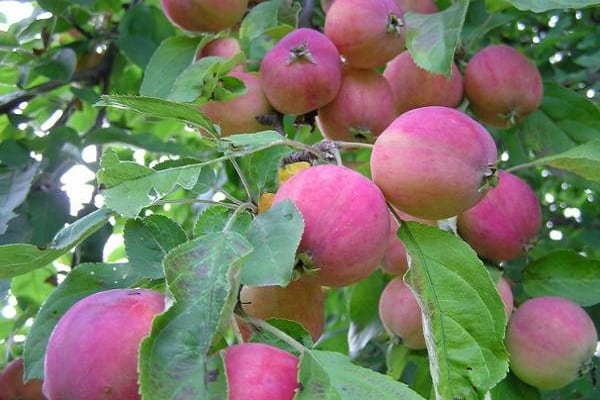
The first forms were obtained by crossing apple trees Berry (M. baccala) and Home (M. domeslica). In Russia, Michurin was engaged in the selection of Kitaek apples. Using the Mentor method, he developed two hybrids: Kandil, Bellefleur.
The aim of the breeding work was to obtain winter-hardy fruit trees with improved fruit quality. He took local and southern varieties as material for hybridization. Michurin did a great job of raising hybrids, the result is the long-lasting varieties of Kitayka.
Modern selection is aimed at obtaining medium-sized, winter-hardy, drought-resistant Kitayka hybrids (height from 5 to 6 meters), with annual fruiting. Seedlings of modern Kitaets take root well in the middle lane.
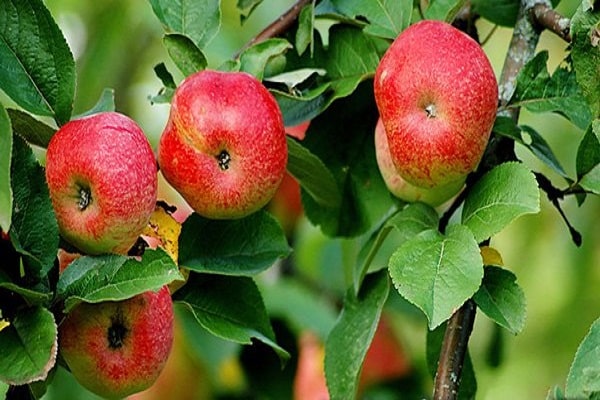
General characteristics of the variety
The Chinese woman has the qualities of a good pollinator, she blooms profusely. A gardener with a fruit tree of this variety does not experience yield problems. Apple trees growing next to Kitayka always delight with their harvest.
Tree height and crown width
Trees in most varieties are vigorous - from 9 to 10 m tall, but there are also low-growing varieties of Kitayka - 2-3 meters. The crown is formed by powerful branches extending upward from the trunk at an acute angle. Formative pruning is required for most varieties of Chinas.
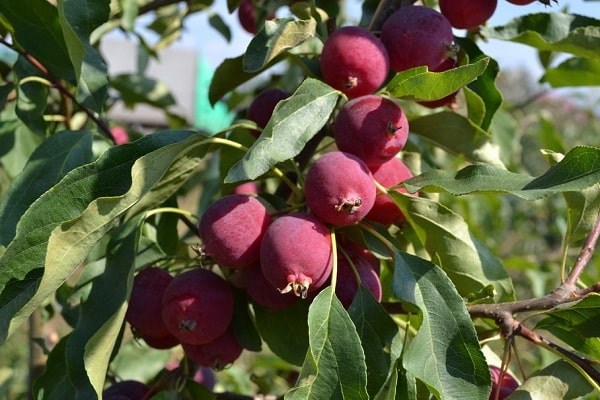
In mature trees, the crown has a conical or round shape, dense. Leaves are finely serrated, glossy, with a sharp tip. The bloom is profuse, showy. The color of the flowers depends on the variety: white, pink, reddish. The bark on the trunk is thick, brown, with a gray tint. The roots are highly branched, shallow.
Harvest amount
Different varieties begin to bear fruit at different times. Before purchasing a seedling, you need to familiarize yourself with its varietal characteristics. Abundant harvests in some forms are annual, in others - periodic. Some hybrids (varieties) of Kitayanka are more productive at a young age, while in others the volume of fruits increases as the tree matures.
Taste qualities of fruits
The size of the fruits is not striking, they are small. The average size of apples of any kind of Kitayka is 40 g. Skin color is yellow or red, the color may be uneven (darkening). The skin is rough. Description of the characteristics of the fetus:
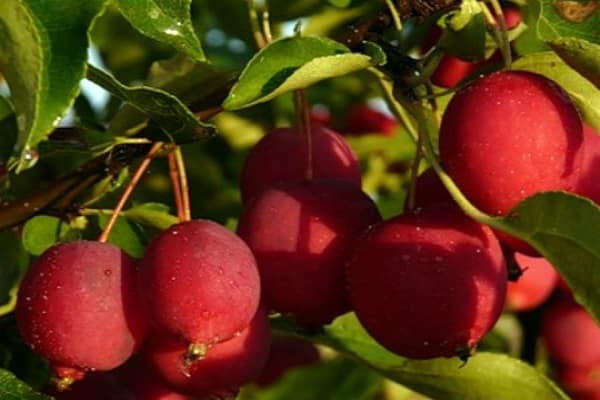
- round or ovoid shape;
- diameter about 2 cm;
- weight 25-40 g;
- the pulp is creamy;
- the taste is sweet and sour;
- strong aroma.
The main direction in the use of Kitayka fruits is the production of jams and compotes. Bellefleur is suitable for drying. Mousses, liqueurs, cider, and jelly made from apples are distinguished by good taste. They give a special piquancy to meat. Goose stuffed with apples acquires an exquisite taste and aroma during roasting.

Frost resistance
Michurin also singled out among all the forms of Kitaets the most winter-hardy - Anisova. It remains at 50 ° C frost. Amateur and professional gardeners use the cherry apple tree to obtain new frost-resistant, drought-resistant forms.
Apricot Kitayka is popular in the Trans-Urals for its yield and frost resistance. Up to 10 kg of fruits are harvested from one tree per season. The average fruit weight is around 60 g.
Disease immunity
Almost all varieties of Kitayka have a weak or medium immunity to scab (leaves and fruits). Prevention of fungal diseases and protective measures against insect larvae, pests can improve the commercial quality of fruits, reduce crop losses.
The subtleties of growing in different regions
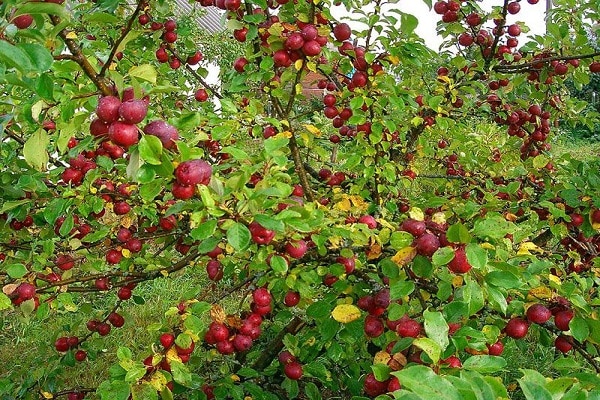
On the vast territory of Russia, Kitayka can be found in various climatic zones. Each region has its own peculiarities of planting, caring for this species of apple trees. Trees of this species are undemanding to the composition of the soil, but when better conditions are created for them, they bear fruit longer and more abundantly.
In Siberia
For better survival rate, the seedlings after planting are treated with stimulants "Bud", "Energen". 3-year-old plants are taken as planting material. For the winter, the bole of young trees is insulated with a covering material, the soil is mulched. Before the onset of frost, protective watering is carried out, fed with 2-component mineral fats containing potassium and phosphorus.
In outskirts of Moscow
The seedlings are planted in early April. Pits are dug to a depth of 70 cm. For filling, drainage is used - a 20 cm layer of gravel or gravel with sand. Crown pruning is carried out immediately after planting. The central conductor is shortened at a height of 0.8 m, competitors are cut out, the remaining shoots are shortened by ⅔ of the length.
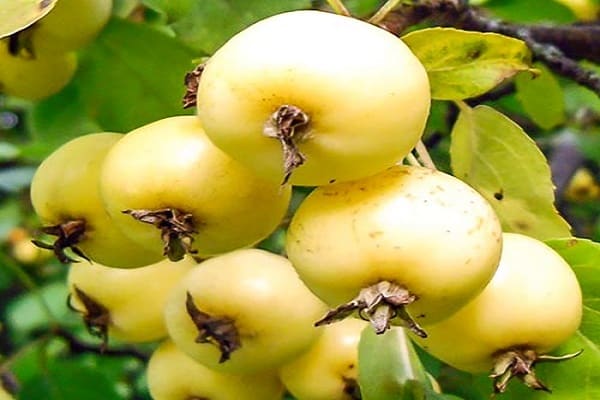
In the Leningrad region
The first days of October are the best time to plant. The soil for filling the planting pit is prepared from the following components:
- peat;
- humus;
- leafy land;
- mineral fertilizers (superphosphate, potassium nitrate).
Caring for Kitayka in the Leningrad Region is standard: watering, pruning, feeding.
In the Urals
Kitayka is planted in the Urals in early May. Planting pits are prepared in the fall. A set of mineral fertilizers containing phosphorus, nitrogen, potassium is introduced into the backfill soil. A stake is placed in the center of the pit, it is necessary for tying the seedling. This region is characterized by strong winds. The support will prevent damage to the trunk and young shoots. For the winter, the trunk circle is covered with a 5-centimeter layer of mulch.

In the middle lane
Planting of Kitaek apple trees is carried out in April (1-2nd decade). Compost, sand, humus and mineral fertilizers (according to the norm) are added to the backfill mixture in equal proportions. When backfilling, control the level of the root collar above the soil surface. It should be from 5 to 6 cm.Care for a Chinese apple tree in the Middle Lane:
- watering;
- control over the purity of the soil;
- measures for the prevention and treatment of diseases;
- formative and sanitary pruning;
- feeding.
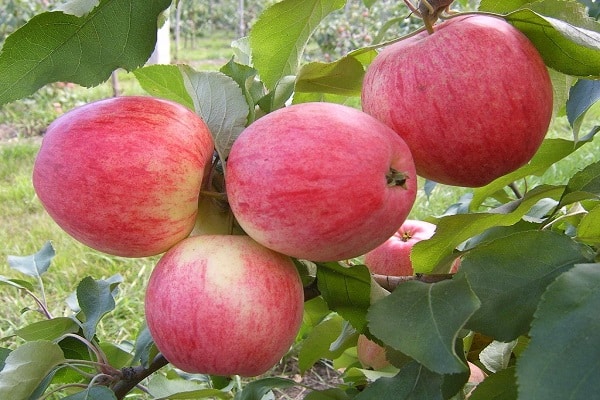
In the northern regions
They are engaged in planting in September (15-20 number). Carefully prepare the soil so that the seedling takes root quickly and well. Signs of good soil:
- loose;
- allows water and moisture to pass through.
In the northern regions, the soil is heavy, so they dig a hole deeper - 90 cm and wider - 100 cm. At the bottom it is recommended to put turf and manure mixed with sifted ash. For the winter, apple trees are covered with spruce branches (covering material), in spring, summer, and autumn they do not forget about watering and feeding.

Apple planting and care technology
Only young seedlings are transplanted, the grown trees in a new place take root with difficulty. All forms of Kitayka require the same care. They need watering, feeding, pruning. For the prevention of diseases, the trunk circle is kept clean, loosened.
Planting and growing
The soil should not be swampy, the required depth of groundwater is at least 2.5 m. Pits for planting are prepared in advance. Parameters: diameter up to 100 cm, depth 80 cm, distance to the nearest tree at least 6 meters, the crown of an adult Chinese woman is wide.
Backfill mixture:
- humus;
- sand;
- leafy land;
- peat.
Before filling, it is required to add superphosphate to the composition at the rate specified in the instructions for the product. The time for planting is spring, until the buds have blossomed, or autumn - no later than mid-October. Seedlings for planting are taken 2 or 3 years old.
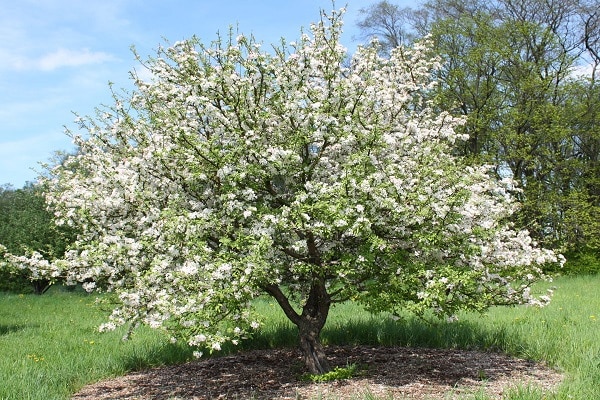
Agrotechnics
The first 2 years Kitayka is not fed, the seedling has enough fertilizers, laid down during planting. This rule does not apply to depleted (non-fertile) soils. After 2 years, feeding should be done annually. In the first half of summer, nitrogen predominates in the composition of the fertilizer mixture, in the second - phosphorus and potassium.
The last time phosphorus-potassium fertilizer is applied after barrier watering (before the first frosts). With proper fertilization, apple trees winter better, bear fruit abundantly every year, and do not get sick.
Young trees are prepared for wintering. To protect the trunk, old newspapers and spruce branches are used. The roots are protected from freezing with a layer of mulch (peat, humus, rotted sawdust), which is removed with the arrival of spring.

To combat diseases and pests, preventive treatments with fungicides are carried out.
| A drug | Period | Diseases |
| Copper sulfate 1% | Before kidney swelling | From rot, fungi, mechanical damage to the bark |
| "Nitrofen" | Before kidney swelling | Powdery mildew, pest larvae |
| Urea | Before kidney swelling | Scab, powdery mildew, aphids, weevil |
| Copper sulfate | Before flowering (buds open) | For regeneration of the bark, control of pest larvae |
| Bordeaux liquid 3% | Before flowering (buds open) | From pests and diseases |
| Colloidal sulfur | Before flowering (buds open) | For fungal infections and ticks |
| "Karbofos" | 20 days after flowering | From aphids, weevils, moths, leafworms |
Pruning and shaping the crown of a tree
Shoots of certain varieties of Kitayka form sharp forks that break under the weight of the crop or a layer of snow. The crowns of such trees must be formed, shoots:
- turn down;
- cut out.
They begin to study the crown when the seedling reaches 2 years of age:
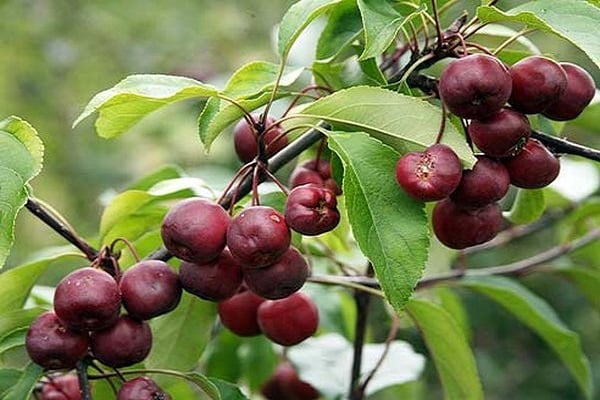
- choose a central conductor, cut out competitors;
- shorten branches that are long.
The guide is shortened to 80 cm. Two types of trimming are practiced. To the outer bud - to expand the crown. On the inner bud - to strengthen the center and raise the shoot.Throughout the life of an apple tree, the crown density is monitored, excess shoots are cut out, and sanitary pruning is the removal of frost-beaten, dry and broken branches by bad weather.
Reproduction
Apple trees are propagated in two ways. The first option is seeds, the second is grafting. For spring sowing, seeds are stratified from December to spring. Freshly harvested planting material is sown in early autumn. For planting in late autumn, seeds are stratified from 1 to 2 months.

Features of ripening and fruiting
Apples of different varieties of Kitayka ripen from mid-summer to mid-September. When choosing a seedling for your garden, you must take into account the peculiarity of this type of apple trees.
The period of the beginning of fruiting
Some varieties begin to bear fruit early, from the year of planting to the appearance of the first fruits, it takes 5 to 6 years. The harvest of other forms takes a long time. Many slimy varieties give first fruits at the age of 8-9 years.
The timing of fruit ripening
The massive apple harvest takes place from August to the end of September. There is not enough padalka. The keeping quality of Kitayka's apple trees is different. Belfleur retains its commercial and consumer properties the longest. After removal, the fruits lie for 4 months, transport is well tolerated.
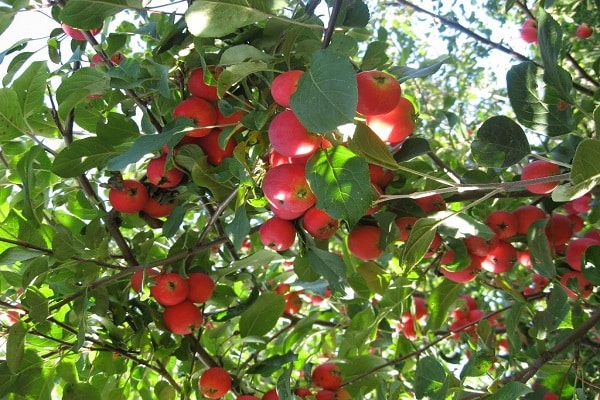
The crop is stored in plastic boxes, wood or baskets. Optimum storage temperature + 2… + 4 ° C. In the absence of a cellar, the fruits are kept in the refrigerator, the undamaged ones are selected, if there is damage on the skin, they are allowed to be processed.
Benefits and qualities of the fetus
The fruits are rich in vitamins. They serve as an excellent prevention of hypertension: they strengthen the walls of blood vessels, stimulate blood circulation. The most delicious apples grow on Dessert Kitayka. The variety is also very productive. Up to 70 kg of fruits are removed from one tree.
The Dolgo apples have a good wine-sweet taste. They are fragrant, stored very little, the jam made from them has a unique taste. Apples of the following varieties are suitable for long-term storage:

- Kerr;
- Long sweet;
- Pepin is saffron;
- Kandil.
Summer varieties of apples are not stored for a long time, but their plus is early fruiting. Eating fresh fruits from your garden helps your body replenish missing nutrients. For lovers of homemade wine, preserves, jams, summer varieties of Chinese do not let them get bored, they give a lot of raw materials for blanks.
Varieties and descriptions of varieties of Kitayka
There are many forms of Chinese. Almost all of them are small-fruited. From a wide variety of unpretentious varieties for each climatic zone, you can choose summer, early ripening, little stored, or late (autumn) with a long shelf life.
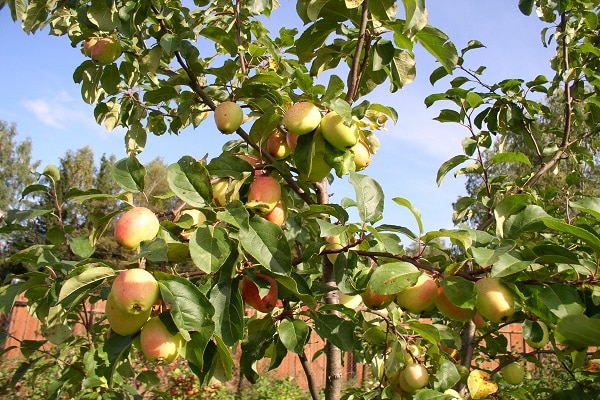
Kerr
Parents - Kitayka Long plus Kharalson. The selection was carried out in Canada. Kerr, according to its characteristics (frost resistance, drought resistance), is suitable for growing in a temperate climate of middle latitudes.
The height of the tree is small, the crown is round, moderately dense, does not require formation. The leaf is elliptical, light green serrated, smooth. The flowers are large, pink in color.
The first crop is harvested in 3-4 years, the harvest time is September. Productivity over the years is uneven. Mature trees have abundant fruiting one year, the next - average. The yield of young apple trees is consistently high. Apples are stored until January, honey notes appear in the taste over time.
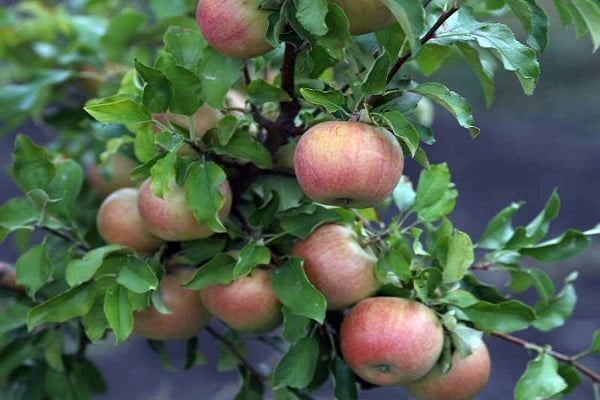
Advantages and characteristics of the Kerr variety:
- weight 45 g;
- elongated shape;
- the skin is dark red;
- the taste is slightly tart, sweet and sour;
- winter hardiness;
- good immunity.
Landscape designers include the Kerr apple tree in their garden compositions.
Red
The author of the variety is V.V. Kichina. Red Chinese yields bountiful harvests, about 160 kg of fruits are removed from the tree. Apples ripen in early September, sit on the branches thoroughly, do not crumble. The first fruiting occurs in the 4th year after planting. Fruit characteristics:
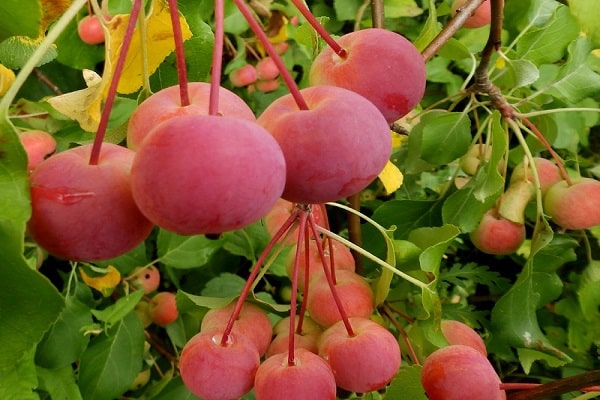
- weight 25 g;
- skin (color) - scarlet;
- stalks are long;
- storage duration no more than 2 months.
4 apples are ripening in Kitayka Red's brush. The variety is successfully grown in the Central Region of the Russian Federation. The use of Kitayka Red is varied, it is used to prepare:
- wine;
- juices;
- jam;
- compotes.
The variety is prone to scab, ripens late, the fruits do not crumble. Caring for the apple tree facilitates the stunted variety.
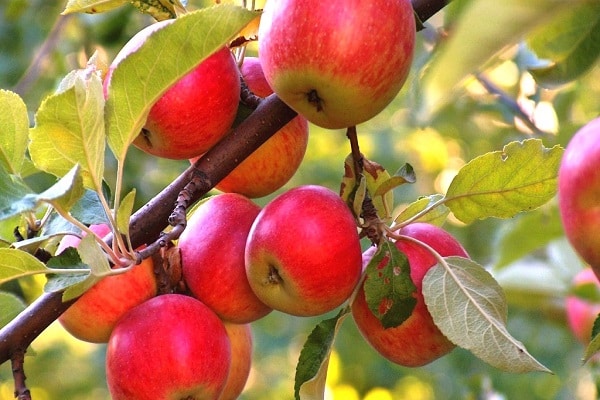
Long
Autumn variety, originally from the USA. In Russia, they have been grown for a long time since the middle of the last century. Early fruiting - the first harvest at 4 years of age. Regions where Kitayka Long is successfully grown:
- Western and Eastern Siberia;
- Northwestern;
- Northern;
- Central.
The plant is undersized, its height does not exceed 4 meters. The shape of the crown is wide, conical or round. There are many branches, leaves with a glossy surface, strongly elongated. The flowers are white, large - up to 4 cm in diameter.
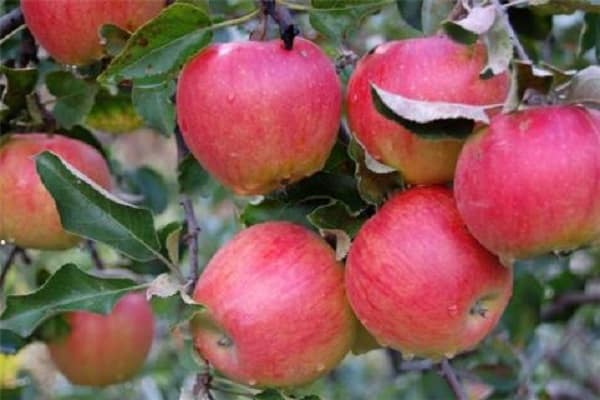
| Parameter | Description |
| Shape (fetus) | Oblong |
| Weight (fruit) | 15 to 20 g |
| Main skin color | Yellow |
| Blush | Bright red |
| Storage period | 2 to 3 weeks |
| Pulp (taste) | Sweet |
| Pulp (color) | Cream |
From the fruits, preparations of excellent taste are obtained: juice, jam, compote. They ripen at the end of August; they carry out a massive harvest of fruits in September. Abundant harvests are not regular. Advantages of the apple tree Long: frost resistance, weak susceptibility to scab.
Yellow
Authors — L. E. Zakubanets, M. V. Kachalkin. The fruits are bright yellow. The tree is columnar, medium-sized. The yield is high. Kitayanka Yellow ripens by mid-August. The fruits are small, the size of a large sweet cherry. Weight not more than 20 g. The variety is resistant to scab.
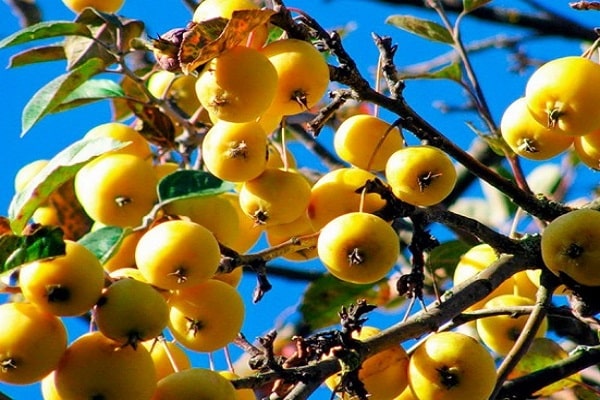
Bellefleur
More than 100 years ago Michurin, as a result of selection, received the late-ripening variety Bifler, which is still grown in the gardens of the North Caucasus region and the Volga region, varietal characteristics are shown in the table.
| Parameter | Value |
| Fruiting | Later, comes after 8 years |
| Yield | High, slightly periodic |
| Ripening period | Late ripe (September, end of month) |
| Winter hardiness | Average |
| Diseases | Susceptibility to scab |
| Wood | Vigorous |
| Crohn (form) | Rounded |
| Fruit (shape) | Rounded-oval, ribbed |
| Weight | 200 g |
| Fruit (skin color) | Light yellow, blush rose red, striped |
| Pulp (color) | White |
| Pulp (structure) | Fine-grained, delicate |
| Taste | Sweet and sour |
Productivity (average) - 150 kg / ha, annual fruiting. Apples are stored for 2 to 4 months. This is an autumn variety, so apples gain flavor in 1-2 weeks after picking. Variety value:
- good taste;
- transportability;
- marketable condition;
- the fruits do not crumble.
When purchasing the Bellefleur variety, you need to know that a 20-year-old tree gives a full harvest, before that the volume of apples harvested is medium and low. Pollinating varieties: Kitayka Saffron, Antonovka, Autumn striped.

Pink
Columnar, small-fruited apple-tree Pink tale. Strikes with beautiful flowering. The color of the buds is red. The height of the tree is from 1.4 to 2 meters. Fruit characteristics:
- weight - 50 g;
- color - red-crimson;
- plaque - waxy.
Fruiting is annual.
Gold
For the Volgo-Vyatka and North-West regions of the Russian Federation, Kitayka Zolotaya is suitable for its characteristics. I.V. Michurin was engaged in its selection, parent material:
- apple tree Kitayka;
- White filling.
The form is early, the fruits of the Golden Kitayka ripen by mid-July. It begins to bear fruit in the 4th year. The tree is tall, about 8 meters. In an adult plant, the crown is pyramidal, spreading, in a young plant it looks more like a broom. The branches are dense, the angle of discharge is sharp. The flowers are white, the leaves are long with slight pubescence, the edge is jagged.
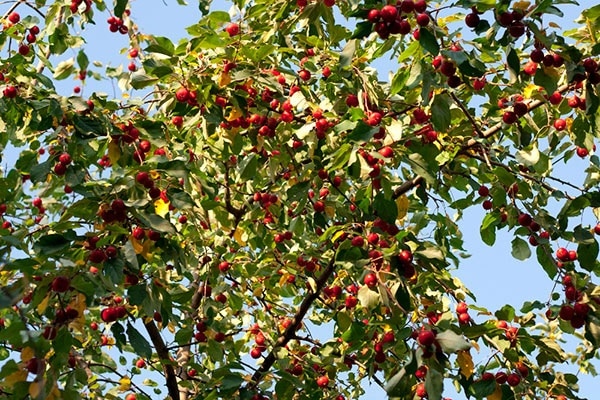
Most of the fruits grow at the end of the branches, their characteristics:
- little is stored - from 7 to 10 days;
- unattractive appearance;
- skin (color) - yellow;
- weight from 40 to 60 g;
- diameter from 5 to 7 cm;
- pulp (structure) granular, soft;
- the taste is sweet;
- strong aroma.
The frost resistance and productivity of the tree is high, the resistance to diseases is low. Fruits are stored a little and quickly crumble, their mistresses use them for various harvests. The pulp of apples on the 4th day after collection becomes wadded.
Saninskaya
The variety is late, autumn, large-fruited. Found Saninskaya Kitayka N.I.Kichunov in the city of Samara (1899). The Saninskaya apple tree is grown in the gardens of the Volga region. Harvesting takes place between late August and early November. For the onset of consumer ripeness, it should take about a week after removal.

Fruits are small with a continuous integumentary color, slightly tart taste, sweet and sour. Apples from Saninskaya Kitayka are used for preparation: wine, jam, juice. Fruits are stored for a short time, from 2 to 3 weeks.
The plant is powerful, tall. A 40-year-old specimen of Kitayka Saninskaya found in Penza had dimensions: height - 9 m, crown width - 8 m. The shape of the crown is spreading, the shoots are weakly pubescent, densely leafy, the color of the bark is olive. The leaf plate is elongated-elliptical, the edge is serrate.
About fruits:
- weight 25 g;
- the shape is different: oval-conical, oval;
- the surface is not smooth, there may be bumps or ribs;
- skin (color) - yellow;
- blush solid red;
- wax plaque;
- pulp (color) - yellow;
- pulp (structure) - granular;
- taste assessment - 4 points.
Valuable qualities of Kitaika Saninskaya: durability, winter hardiness. Among the shortcomings, experts single out the mediocre taste of the fruit.
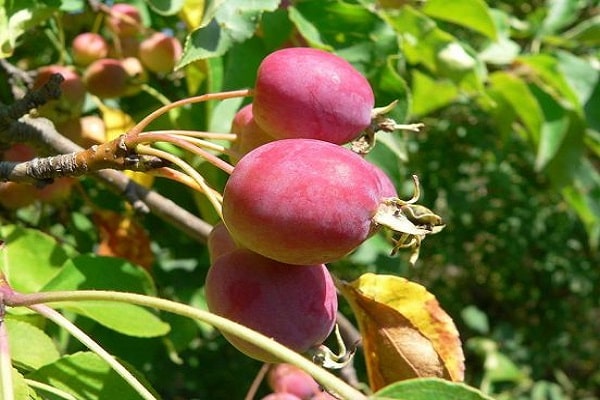
Cream
Author - P.A.Zhavoronkov. In the work I used seedlings of the Kitayka Apricot variety. The plant is vigorous, frost-resistant, according to its characteristics, it is suitable for growing in the gardens of the Urals and Siberia. Crown parameters:
- rare;
- wide pyramidal;
- the stem and branches (bark) are gray;
- shoots (thickness) average;
- the shape of the leaves is elliptical, curved downward, the surface is shiny, wrinkled, the pubescence is weak.

Creamy Kitayka begins to bear fruit in the 5-6th year. A tree at the age of 10-12 years gives 25-40 kg. Fruiting is annual. Ripening periods are average.
| Fruit (characteristic) | Value |
| Weight | 60 g |
| Pulp (color) | Cream |
| The form | Rounded |
| Skin | Not shiny, with a bloom, yellow-green |
| Blush | Pale, red |
| Taste | Spicy |
| Juiciness | High |
Scab fruits are affected weakly or moderately.
Honey
The fruits of the Honey Apple trees have a dessert flavor. Most varieties of this species are summer. During selection, emphasis was placed on frost resistance. The goal of the breeders was to obtain a variety that would bear fruit in any climatic conditions. Among the autumn varieties, Honey Ranet is popular. Its fruits ripen in September-October.
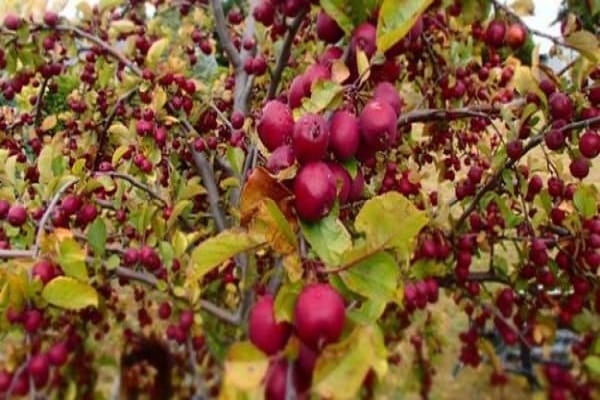
Slate
The dwarf (lily) apple tree is popular in the Moscow region. Small shiny fruits are loved by gardeners. They have a universal purpose, they can serve as raw materials for any kind of workpiece.
Kuibyshevsky
Selection by S.P. Kedrin (Samara Experimental Station). Parental forms: Pepin of London, Antonovka saffron. The variety is widespread in the Middle Volga region. Characteristics of the tree (crown):
- vigorous;
- crown (shape) - broad-conical;
- crown (thickening) - medium;
- branches are thick, the angle of abutment is obtuse;
- bears fruit on ringlets;
- the size of the leaves is average, the edge is crenate, the shape is narrowed, the pubescence is average.

| Fruit (characteristic) | Description |
| Weight | 150 g |
| Surface | Ribbed |
| Skin | Smooth with gloss, medium thickness |
| Coloration | Yellow |
| Blush | Brown red |
| Subcutaneous points | Yes, white |
| Pulp | Cream color, fine-grained structure |
| Taste | Sweet and sour |
Fruits ripen after September 10, retain consumer properties until February. They begin to bear fruit in the 5th year of life, yields are given annually - young apple trees, periodic - adult trees. Good winter hardiness, medium scab resistance.
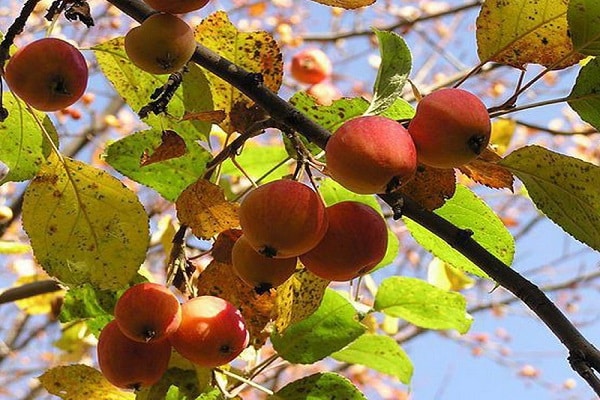
Columnar
Chinatown Columnar tolerates frosty winters well.The height of the trees is average, the crown (shape) is columnar. Branches are covered with yellow-orange bark, thin, long. The harvest ripens by the end of July. High shattering of fruits is a lack of columnar Kitayka.
Description of fruits:
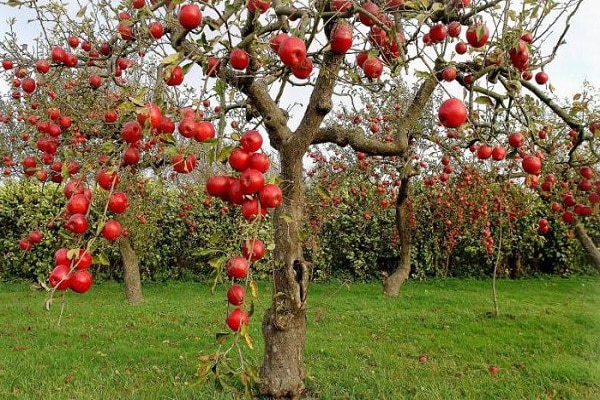
- small size (20 g);
- amber yellow color;
- the peduncle is short;
- the taste is harmonious, sweet and sour.
Apples are stored for a short time (7 days after harvest), they are used as raw materials for the preparation of desserts, preparations for the winter.
For each region of the Russian Federation, you can choose a good variety of Kitayka. Low-fruited apple trees bear fruit steadily and for a long time. Their care is minimal.

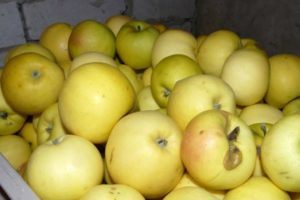
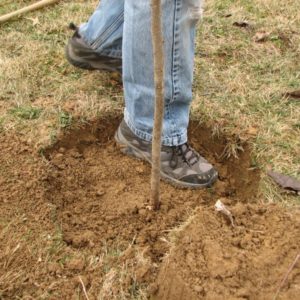
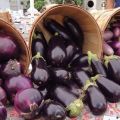


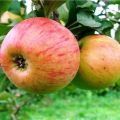

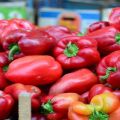
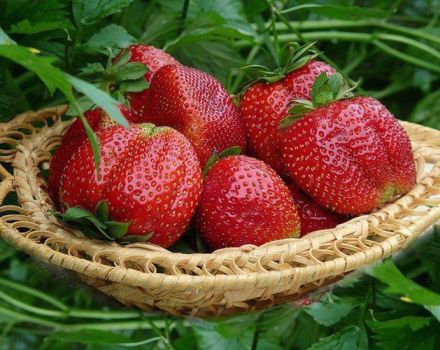
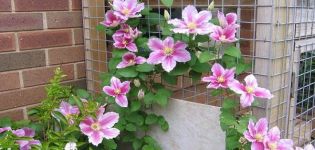
Pictures with varieties of apple trees are confused